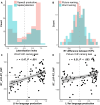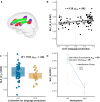Intrahemispheric White Matter Asymmetries and Interhemispheric Connections Underlying the Lateralization of Language Production and Spatial Attention in Left-Handers
- PMID: 39830069
- PMCID: PMC11740161
- DOI: 10.1162/nol_a_00153
Intrahemispheric White Matter Asymmetries and Interhemispheric Connections Underlying the Lateralization of Language Production and Spatial Attention in Left-Handers
Abstract
Leftward language production and rightward spatial attention are salient features of functional organization in most humans, but their anatomical basis remains unclear. Interhemispheric connections and intrahemispheric white matter asymmetries have been proposed as important factors underlying functional lateralization. To investigate the role of white matter connectivity in functional lateralization, we first identified 96 left-handers using visual half field naming tasks. They were then divided into atypical and typical functional dominance based on the lateralization of brain activation in a word generation task (for language production) and a landmark task (for spatial attention). Using a novel fixel-based framework, we obtained fiber-specific properties of white matter pathways. Results showed, first, that differences between two language dominance groups occurred in the asymmetry of the superior longitudinal fasciculus-III (SLF-III), whereas differences between two spatial attention dominance groups occurred in the rostrum and rostral body of the corpus callosum. However, the directions of functional lateralization were not associated with the directions of white matter asymmetries. Second, the degree of language lateralization was predicted by SLF-III asymmetry and the rostral body of the corpus callosum, whereas the degree of spatial attention lateralization was predicted by the rostrum of the corpus callosum. Notably, the degree of each functional lateralization was negatively correlated with the anterior and middle callosal connections, supporting the excitatory model of the corpus callosum. The results suggest that language lateralization is shaped by a combined effect of intra- and interhemispheric connections, whereas spatial attention lateralization relies more on interhemispheric connections.
Keywords: corpus callosum; functional lateralization; language lateralization; language production; spatial attention; superior longitudinal fasciculus.
© 2024 Massachusetts Institute of Technology.
Conflict of interest statement
Competing Interests: The authors have declared that no competing interests exist.
Figures




Similar articles
-
Hemispheric co-lateralization of language and spatial attention reduces performance in dual-task.Brain Lang. 2025 Mar;262:105537. doi: 10.1016/j.bandl.2025.105537. Epub 2025 Jan 24. Brain Lang. 2025. PMID: 39862750
-
Musicianship and Prominence of Interhemispheric Connectivity Determine Two Different Pathways to Atypical Language Dominance.J Neurosci. 2024 Sep 11;44(37):e2430232024. doi: 10.1523/JNEUROSCI.2430-23.2024. J Neurosci. 2024. PMID: 39160067 Free PMC article.
-
Variation in homotopic areas' activity and inter-hemispheric intrinsic connectivity with type of language lateralization: an FMRI study of covert sentence generation in 297 healthy volunteers.Brain Struct Funct. 2016 Jun;221(5):2735-53. doi: 10.1007/s00429-015-1068-x. Epub 2015 May 27. Brain Struct Funct. 2016. PMID: 26013303
-
Intrahemispheric white matter asymmetries: the missing link between brain structure and functional lateralization?Rev Neurosci. 2016 Jul 1;27(5):465-80. doi: 10.1515/revneuro-2015-0052. Rev Neurosci. 2016. PMID: 26812865 Review.
-
Intra- and Inter-hemispheric Connectivity Supporting Hemispheric Specialization.2016 Mar 11. In: Kennedy H, Van Essen DC, Christen Y, editors. Micro-, Meso- and Macro-Connectomics of the Brain [Internet]. Cham (CH): Springer; 2016. 2016 Mar 11. In: Kennedy H, Van Essen DC, Christen Y, editors. Micro-, Meso- and Macro-Connectomics of the Brain [Internet]. Cham (CH): Springer; 2016. PMID: 28590670 Free Books & Documents. Review.
Cited by
-
Effects of Lateralization of Language on Cognition Among Left-Handers.Neurobiol Lang (Camb). 2025 Apr 24;6:nol_a_00165. doi: 10.1162/nol_a_00165. eCollection 2025. Neurobiol Lang (Camb). 2025. PMID: 40330321 Free PMC article.
References
-
- Bakhit, M., Hiruta, R., Iwami, K., & Fujii, M. (2022). Volumetric asymmetry of the major association white fibers in healthy young adults. Neuroscience and Behavioral Physiology, 52(5), 791–805. 10.1007/s11055-022-01241-3 - DOI
LinkOut - more resources
Full Text Sources
